This post is a result of my very kind mother-in-law gifting me some vintage DuBarry items, which she found while cleaning out her deceased mother's belongings. She knew I would appreciate them and give them a good home, and I'm really pleased to have vintage makeup that came from a family member. I'm okay with buying vintage items without knowing anything about who they belonged to, but obviously I feel more of a connection to the object when they come from someone I actually know. Anyway, these items inspired me to learn a little more about the DuBarry line and, of course, purchase some other items so they didn't feel so alone. 😉
I'm not going to rehash the entire history of the line, as both Cosmetics and Skin and Collecting Vintage Compacts have excellent, thorough histories of both DuBarry and Richard Hudnut, the founder of the line (along with many other brands.) The story in a nutshell: DuBarry originally started as a fragrance developed by Hudnut in 1902. In 1929 a makeup and skincare line was spun off the fragrance as an additional revenue source. The line wasn't doing so well by the late 1930s; however, ever the businessman, Hudnut expanded his lucrative "Success School" (a charm school to prepare young debutantes for their coming out events) to include a new DuBarry "Success Course" that borrowed many of the same principles but without the debutante focus. Part fat camp, part beauty and fashion tips, the Success Course earned the company over $4 million in a little over 3 years. Not only was it a major money-maker, the course also helped the DuBarry makeup line gain significant brand recognition. Since the 1960s the company passed through many owners but is still being sold today.
Without further ado, let's take a peek at some notable DuBarry items from their golden age (roughly 1940s-60s). I found this beautiful fan-shaped color guide over at the Baltimore Shoeseum, an online museum that specializes in swing era artifacts. Let's hear it for another Baltimore-based online museum! I'm sort of tempted to call and ask if they'd be willing to deaccession it to me, as I think the Makeup Museum would be a better fit. ;) I think this is from the early '30s.
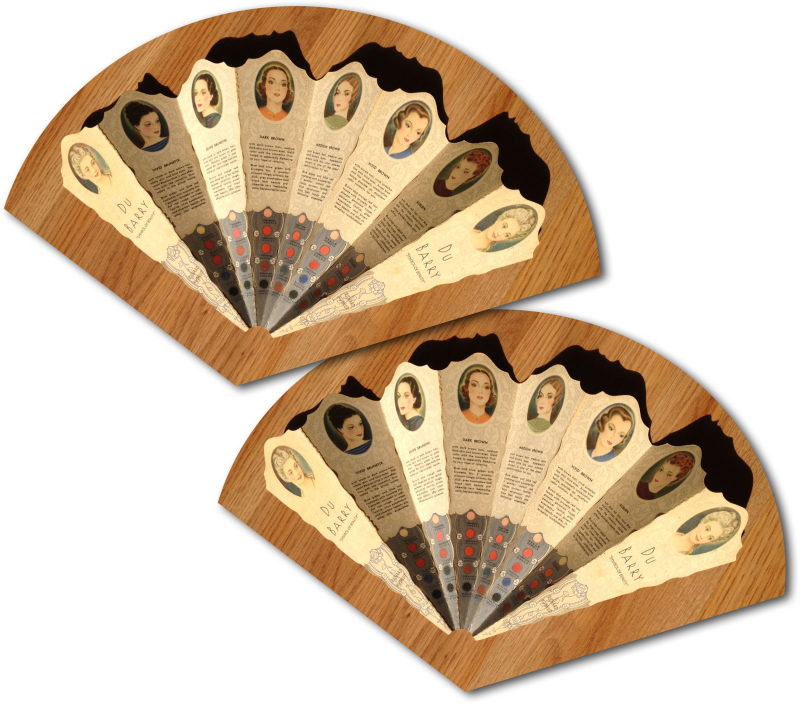 (image from baltimoreshoeseum.com)
(image from baltimoreshoeseum.com)
But what DuBarry was particularly known for was the use of an image of Madame du Barry, a.k.a. the last mistress of Louis XV who, along with rival Marie Antoinette, lost her head in 1793. Collecting Vintage Compacts' entry notes that Hudnut named the line after Madame du Barry, but I'm curious to know what the source is on that and why Hudnut chose her. In any case, there is no fabled tale of how Hudnut arrived at using Madame du Barry as inspiration the way there was with Harriet Hubbard Ayer's Madame Recamier skincare. And it shows: the company came up with vague likenesses of Madame du Barry for the product packaging rather than borrowing a real portrait.
The powder box below looks quite early and also resembles this etching.
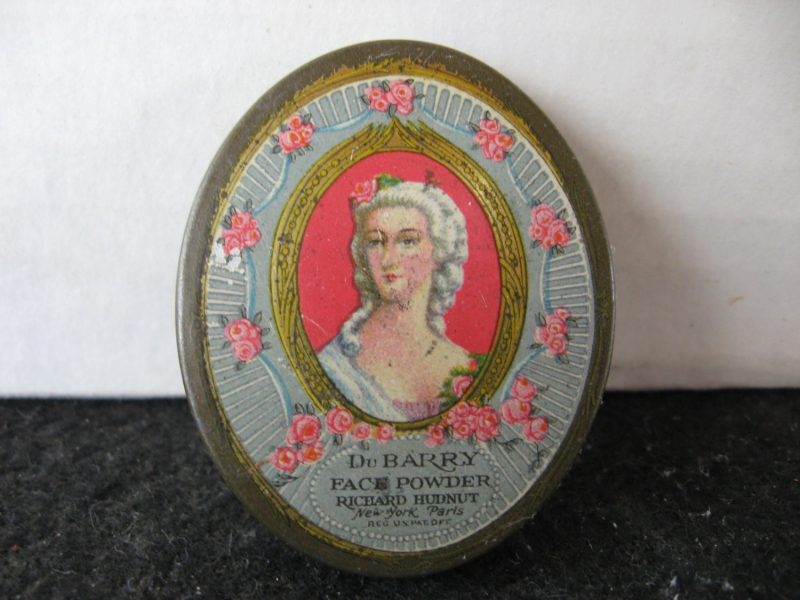 (image from etsy.com)
(image from etsy.com)
This box also appears to be very early and is somewhat similar to this portrait. These two boxes are the only ones I've seen with these particular designs, so I wonder if they were samples or prototypes not actually put into mass production.
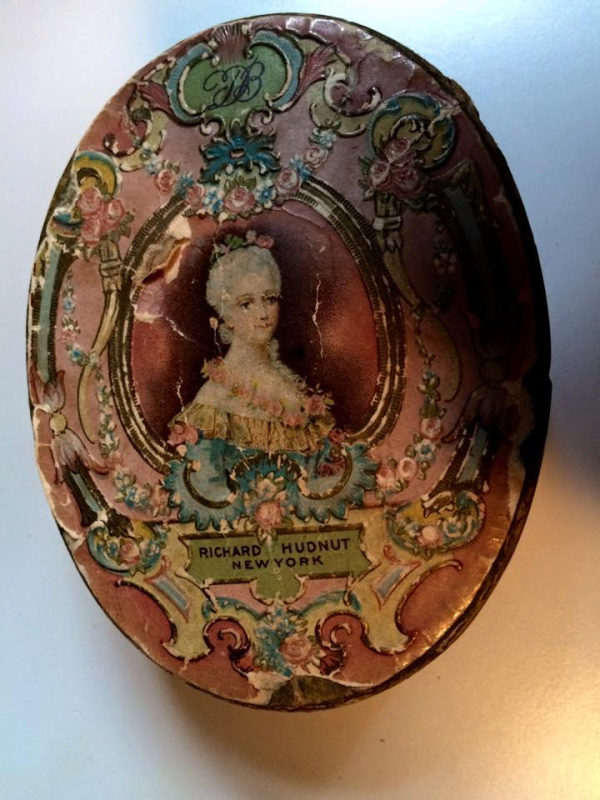 (image from etsy.com)
(image from etsy.com)
The only exception to DuBarry's lack of faithful reproductions of the Comtesse was a sketch of a sculpture by Augustin Pajou.
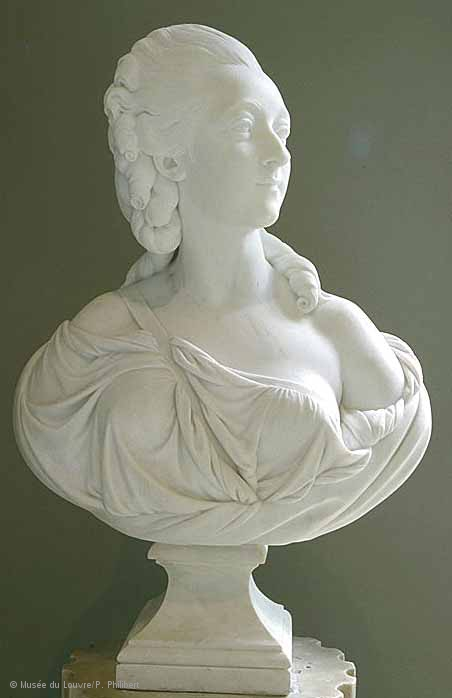
(image from louvre.fr)
Roughly from the start of the line in 1929, DuBarry utilized a drawing of the sculpture for ads and powder boxes and continued to use it up until the early to mid '40s.
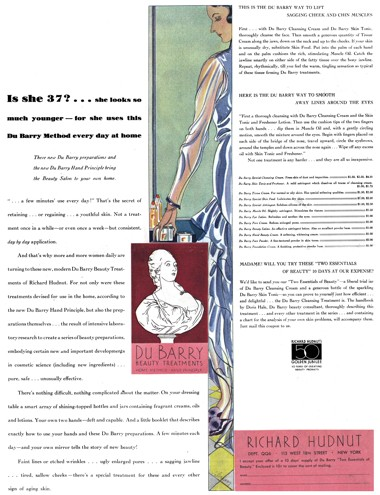
(image from cosmeticsandskin.com)
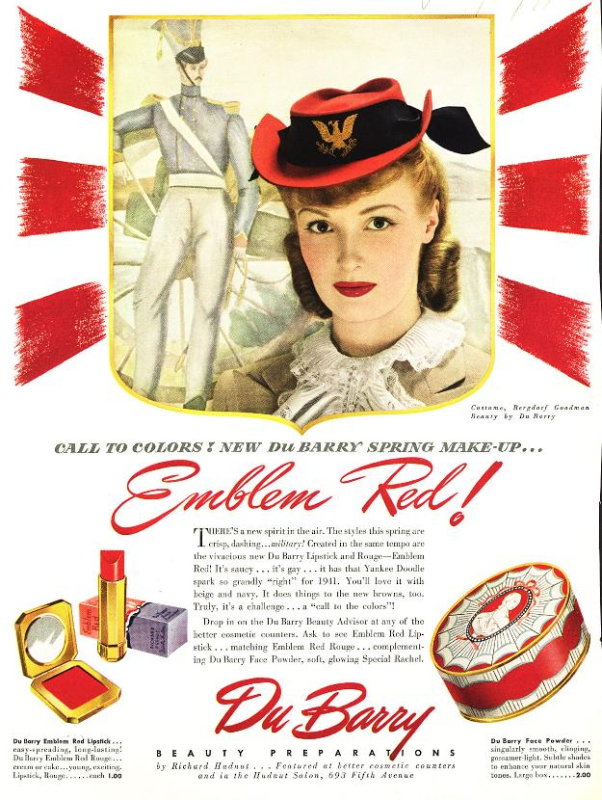 (image from library.duke.edu)
(image from library.duke.edu)
Naturally I had to get one to add to the Museum's collection.
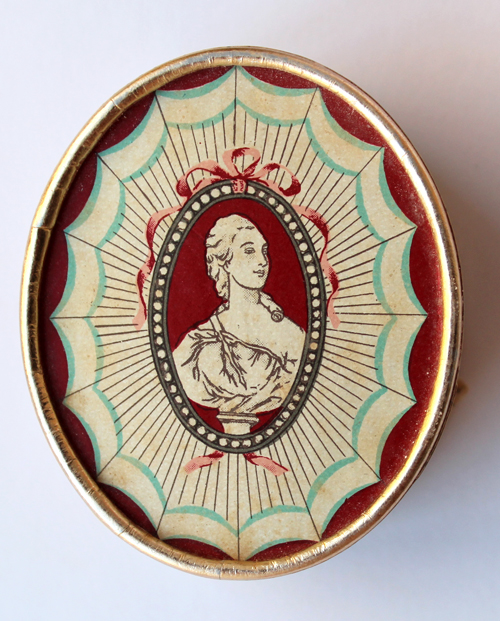
Okay, maybe I got 2! But the design was a little different and I figured variety couldn't hurt.
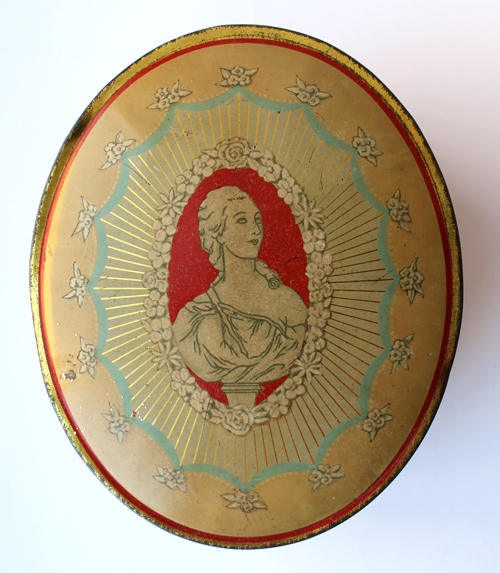
I also liked the pattern on the sides.
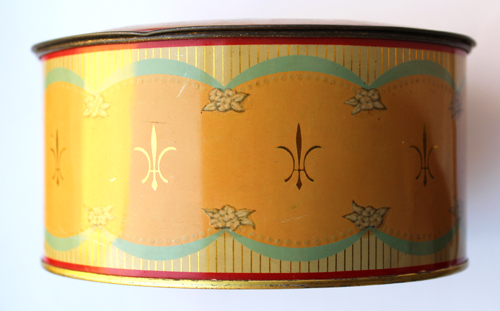
Just to give you a sense of the size, that 2nd box is body powder and way bigger than the face powder pox.
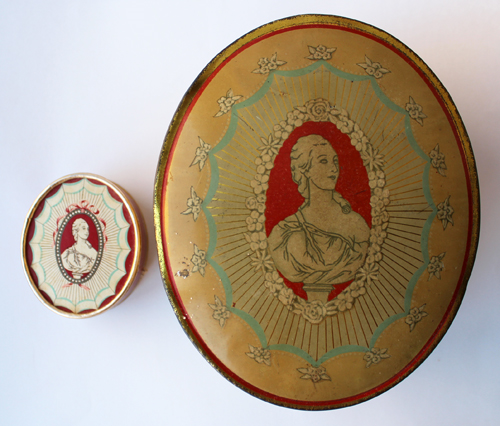
But starting around 1935 (at least according to the ad below), DuBarry displayed a different, completely imaginary representation of Madame du Barry, and it appears that in 1942 they began adding her to their packaging and phasing out the other, accurate Madame du Barry depiction. I've looked everywhere online and there is no portrait of Madame du Barry that even remotely resembles this one.
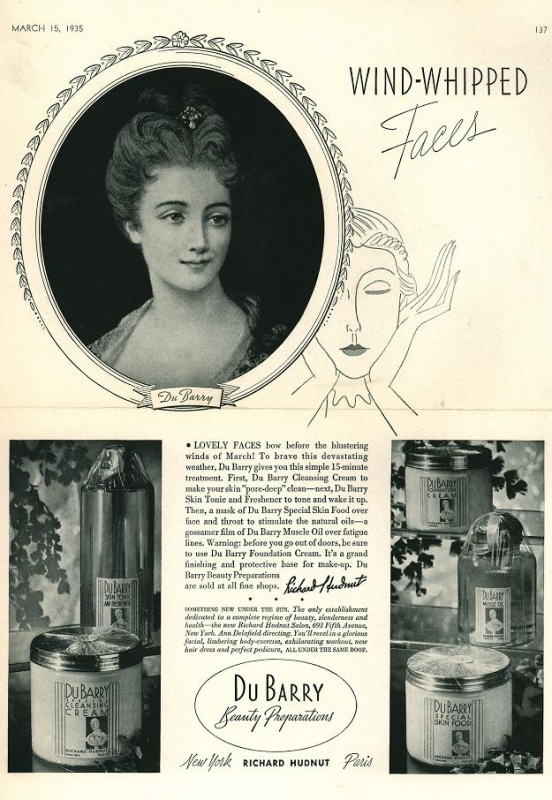 (image from library.duke.edu)
(image from library.duke.edu)
It appears to be an amalgam of the Pajou sculpture (the asymmetrical, drapey neckline), this 1770 portrait by François-Hubert Drouais (hair is up with one lone curl around the neck), and this 1771 portrait, also by Drouais (hairstyle is similar, although DuBarry seems to have swapped out the blue ribbon for a blue jewel on the packaging). You can see, however, that the woman on the box is not a direct copy of any portrait, as was the case with the Pajou sculpture.
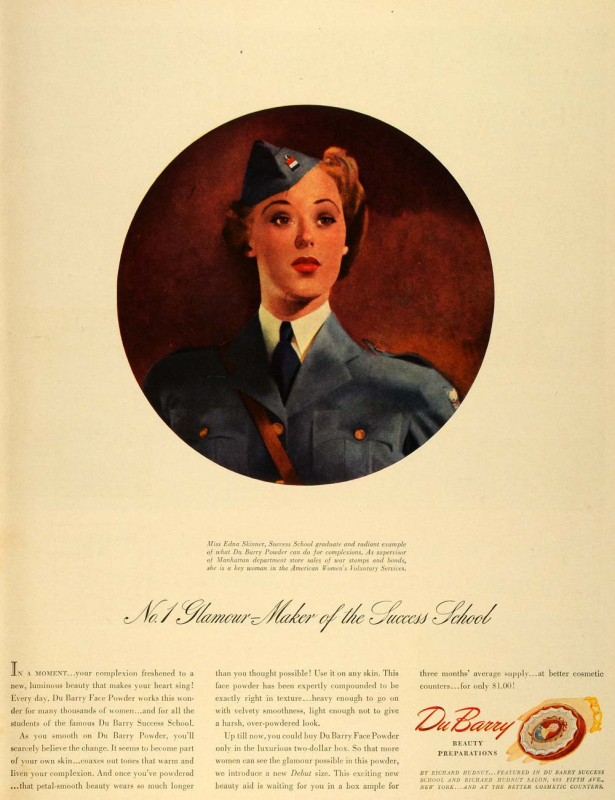 (image from periodpaper.com)
(image from periodpaper.com)
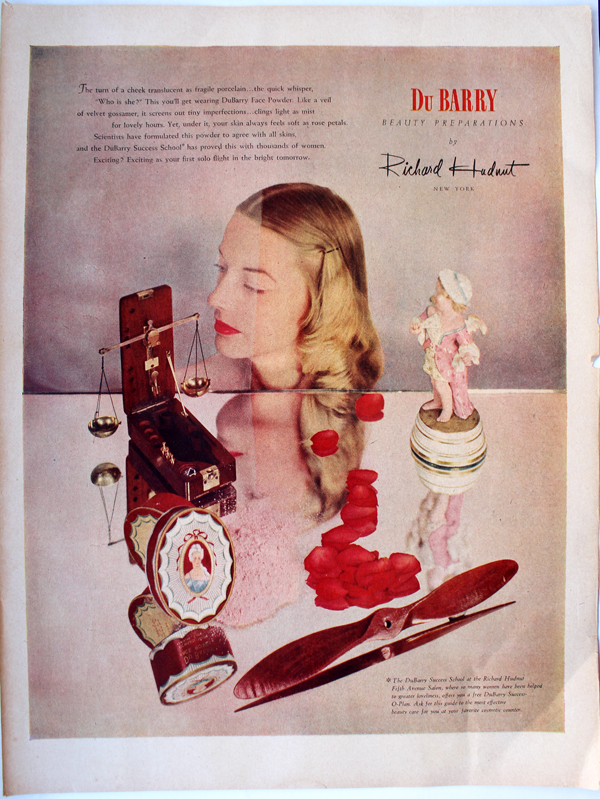
I bought this one too, along with the ad above. 🙂
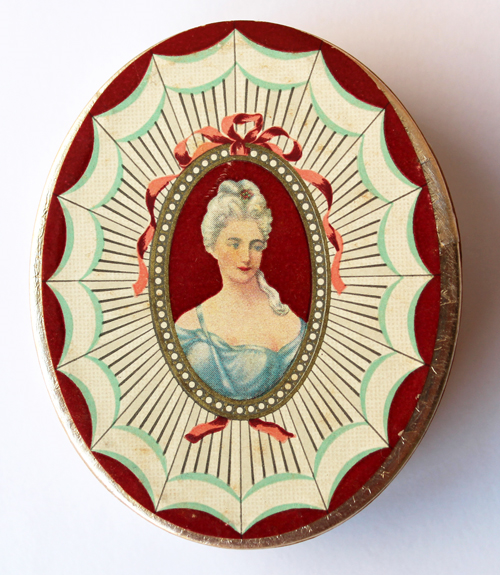
Then in 1949 DuBarry changed the likeness on the packaging yet again. This time Madame du Barry appears with the ridiculously high powdered wig hairstyle that we associate with the French Revolution era. Again, as far as I could tell, there is no portrait of Madame du Barry that resembles this – here's the closest one I found – but even the face on this DuBarry packaging looks nothing like her!
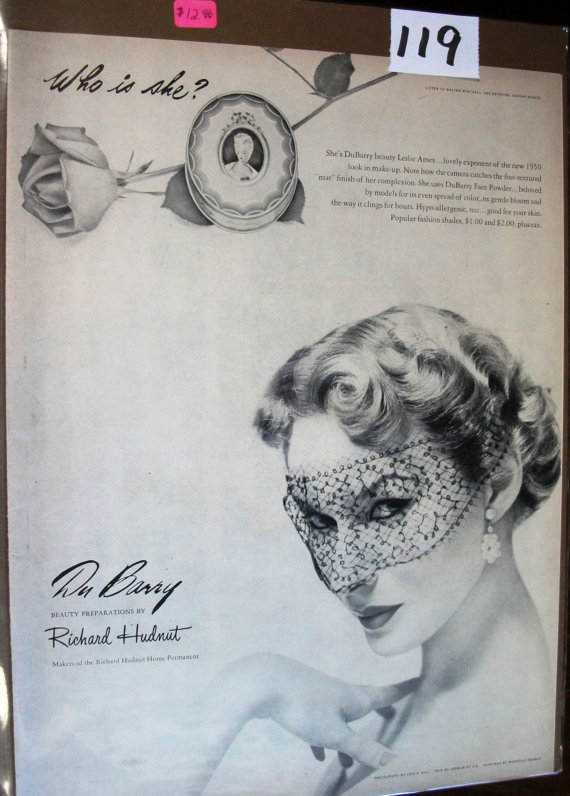 (image from etsy.com)
(image from etsy.com)
This image was used through the mid 1950s.
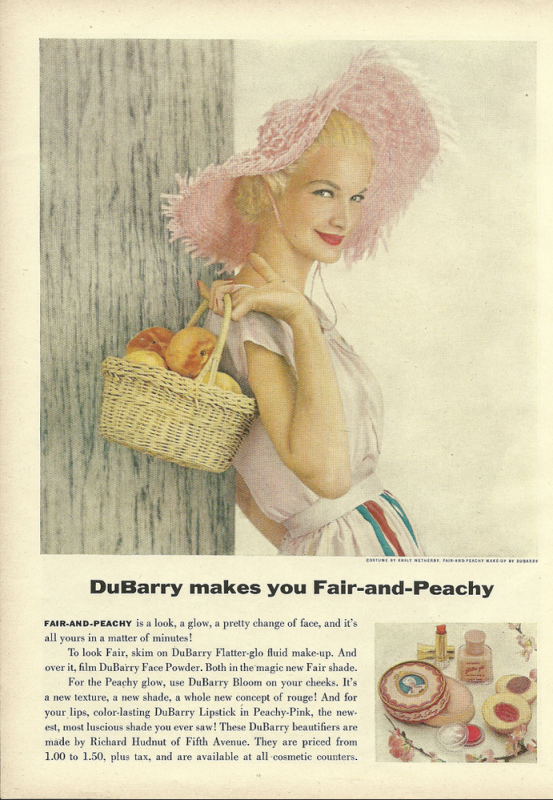 (image from flickr.com)
(image from flickr.com)
To round out the Madame du Barry representations I had to get this one too. This is probably the most common DuBarry box I came across.
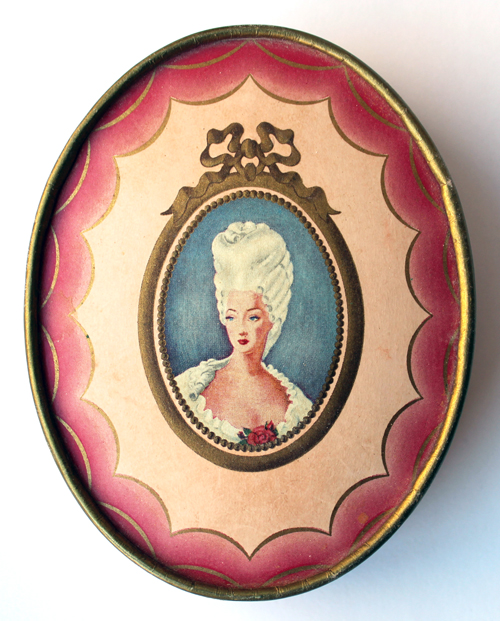
The next item I thought would be a nice addition to the Museum's DuBarry holdings were these lipstick blotting sheets. Clearly men are the only ones who are affected by lipstick transfer and it's their comfort we have to worry about most, not the simple fact that women would just like a lipstick that stays put so we're not constantly touching up. *eyeroll* Still, I thought it was amusing that they put a cartoon man on the case and I don't have any vintage lipstick blotters in the Museum's collection. (And like the DuBarry powder boxes it was super cheap, which is always a plus.)

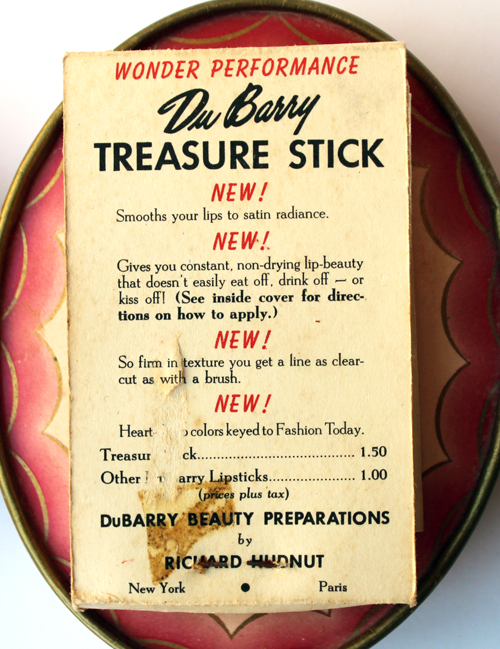
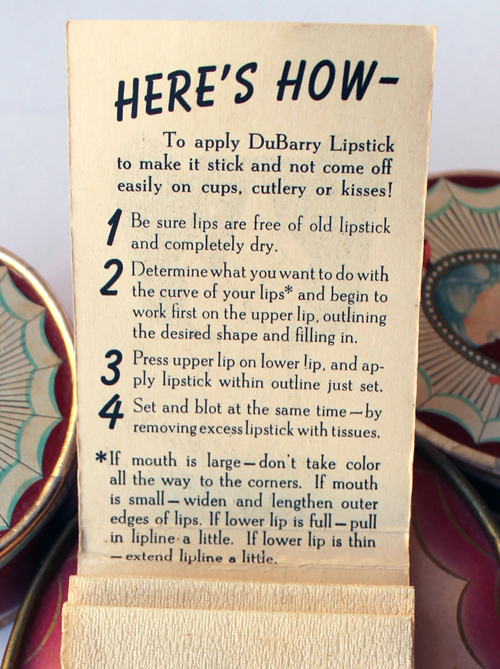
Based on the graphics I really thought this was from the early '60s, but I was way off. Turns out DuBarry's "Treasure Stick" lipstick was introduced in 1947 and was sold at least through 1951, according to the ads below, so these blotting sheets are from around then as well.
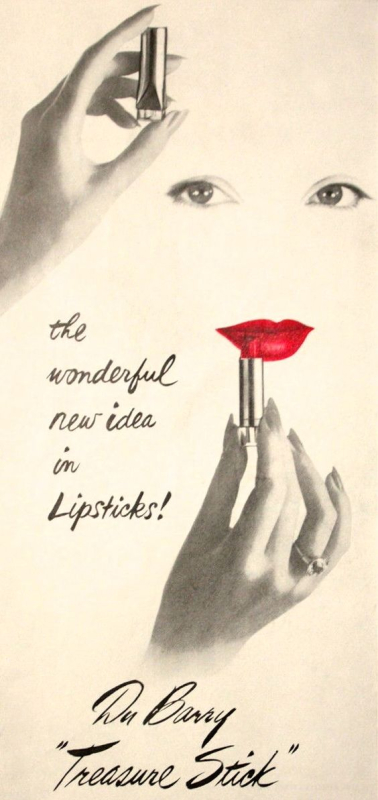
(image from pinterest.com)
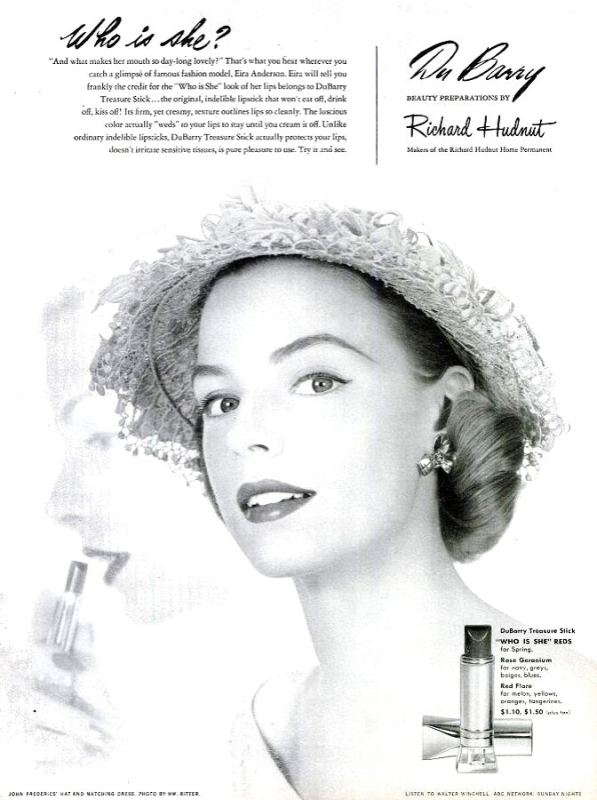 (image from etsy.com)
(image from etsy.com)
Finally, here are the items that once belonged to the husband's grandmother which my mother-in-law kindly passed along to me. Thanks, M.!
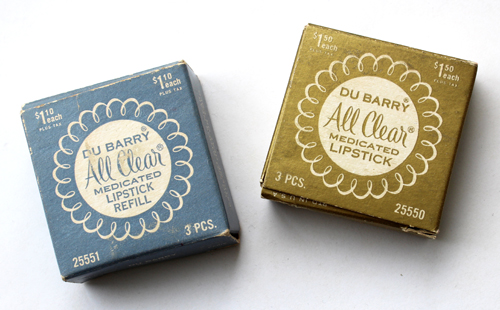
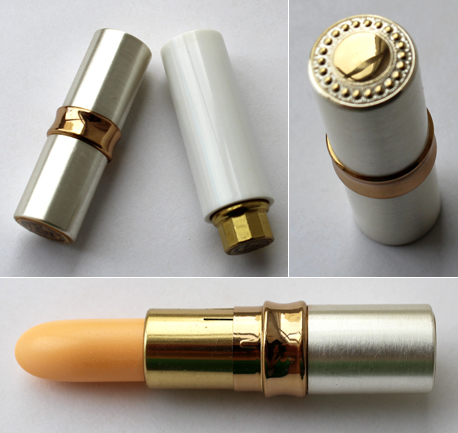
Naturally I was eager to find out approximately when they were from. Just at first glance they appeared to be early '60s to me, but I couldn't say so with any certainty, so off I went to search for clues. Based on the ads below it didn't look like the lipsticks I have are from the '40s.
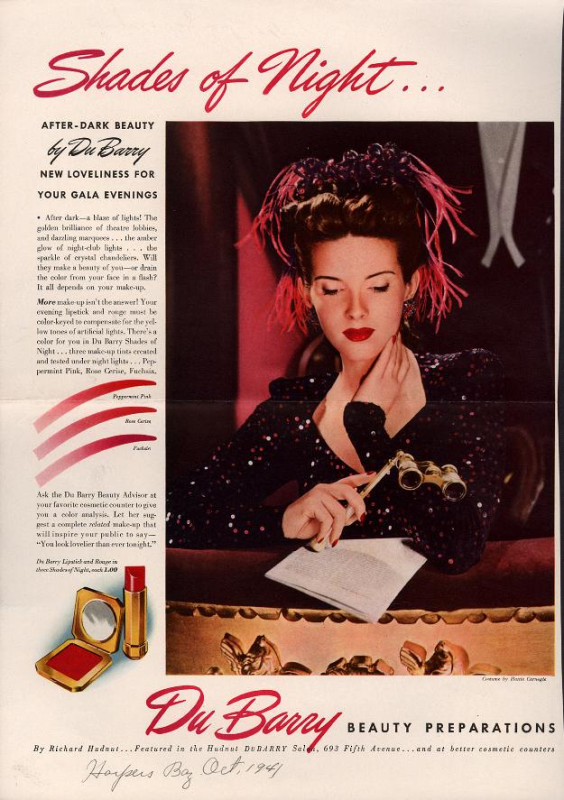 (image from library.duke.edu)
(image from library.duke.edu)
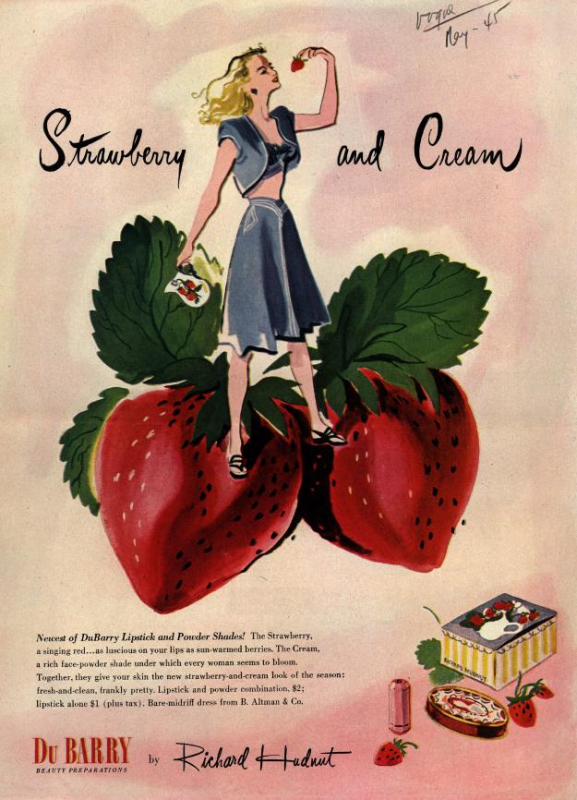 (image from library.duke.edu)
(image from library.duke.edu)
It wasn't from the mid-'50s either.
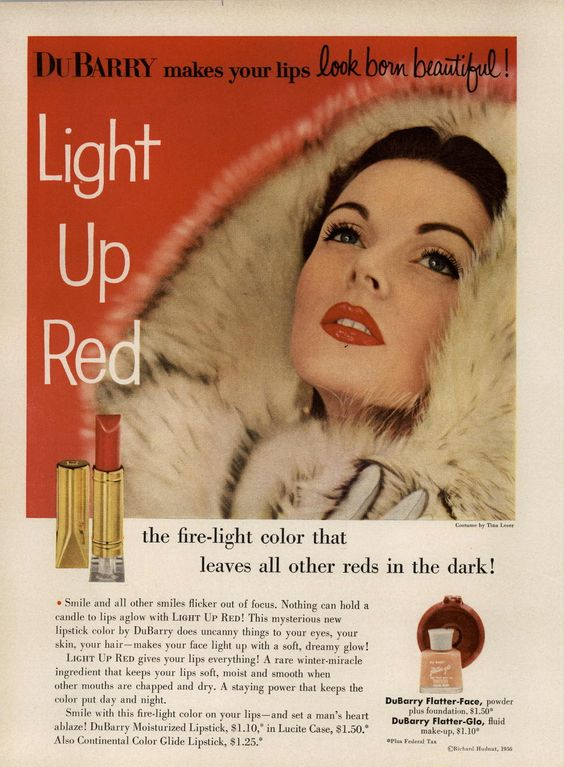 (image from pinterest.com)
(image from pinterest.com)
Low and behold, in 1958 we see a new lipstick tube and bullet that are very similar to those bestowed upon the Museum. With the debut of the "Royal" lipstick (you've seen this ad before), there also came a new case. However, it's gold-toned and not silver like the ones I have. Hmmm…
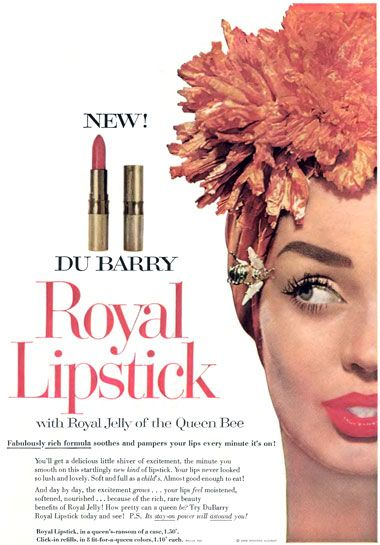
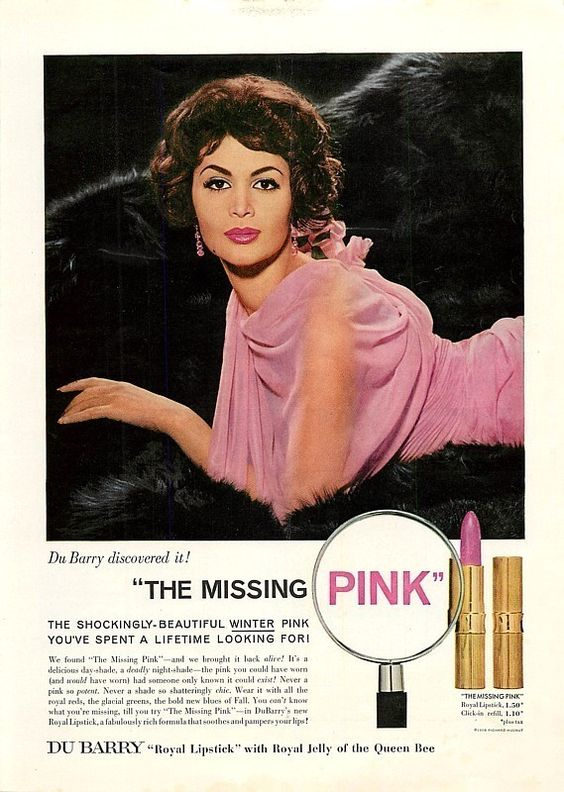
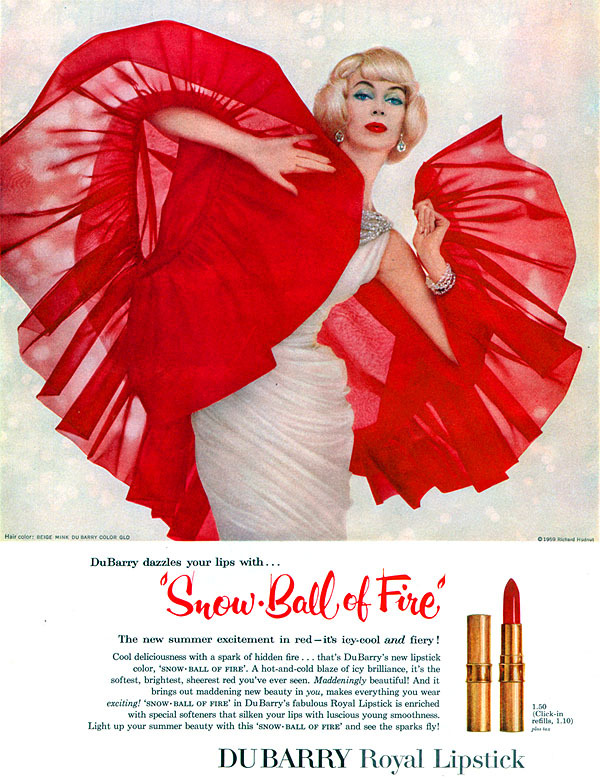 (image from mudwerks.tumblr.com)
(image from mudwerks.tumblr.com)
It's hard to tell, but judging from this 1961 ad below, it looks like DuBarry made the switch to the silver casing by then.
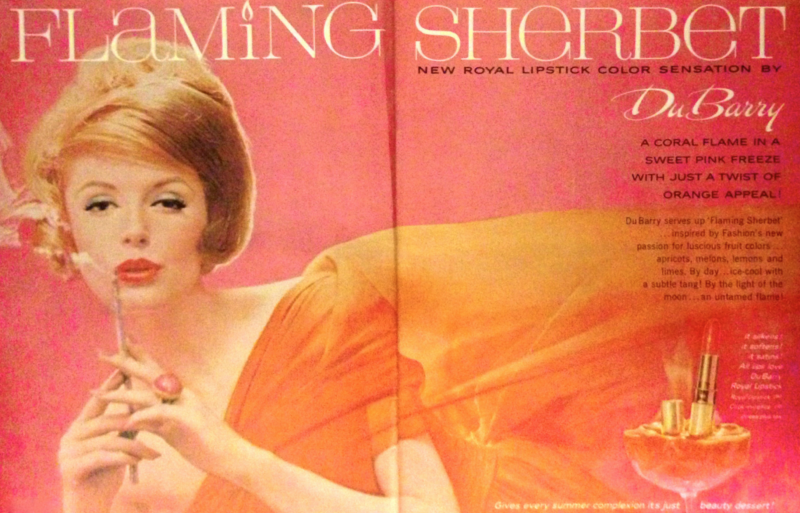 (image from pinterest.com)
(image from pinterest.com)
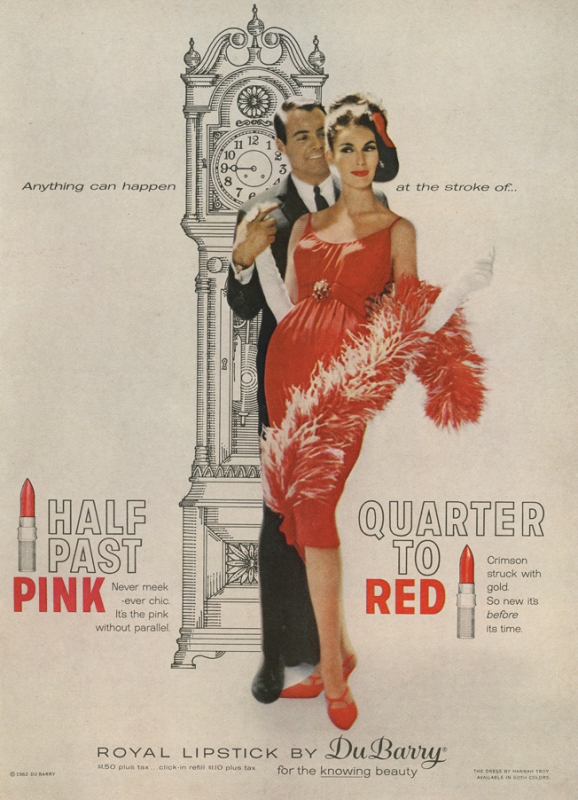 (image from adweek.com)
(image from adweek.com)
So while I'm still not 100% sure, I can say with confidence that the lipsticks I was given date from the late '50s or early '60s, especially given that the prices are the same on the refill boxes and in the ads.
Just for fun, how cute is this "Morning Noon and Night" set? Now that would be quite a find!
 (image from pinterest.com)
(image from pinterest.com)
DuBarry went on to launch a pretty interesting campaign for their Glissando range starting in 1964 – at least, from an advertising point of view. Since there were so many ads I simply couldn't narrow it down, but they were a good representation of mid to late '60s style. As noted earlier, the brand changed hands several times over the years but is still around today. I kind of wish they would look to their golden age and re-introduce packaging with an updated (and accurate) depiction of Madame du Barry. As Collecting Vintage Compacts points out, the Comtesse's consumer appeal cannot be denied: "[The DuBarry] fragrance could not have failed to be recognized by the buying public as representing the essence of feminine beauty, intrigue and even a hint of scandal." Indeed, I can see many people buying makeup with the King's favorite adorning the packaging. 🙂
So those are some highlights from DuBarry when they were in their prime. Which ones did you like best?
Save
Save
A few years back I explored makeup that visually resembled sweets. But what about makeup that actually smells like desserts and other foods? Sure, bath and body products and skincare items with foodie aromas have been popular for years, but I found it interesting that color products, i.e. items worn on the face that usually aren't scented at all or with the typical floral/herbal scents, are being made to smell like chocolate and other edible delights. So let's take a look at when this phenomenon started and where it's headed.
The earliest evidence of flavored/scented makeup that I could find is from the late '1930s. I'm not sure whether these lipsticks were eventually released for sale or even what brand they were, but here are some happy ladies testing them in the May 1939 issue of Popular Science.
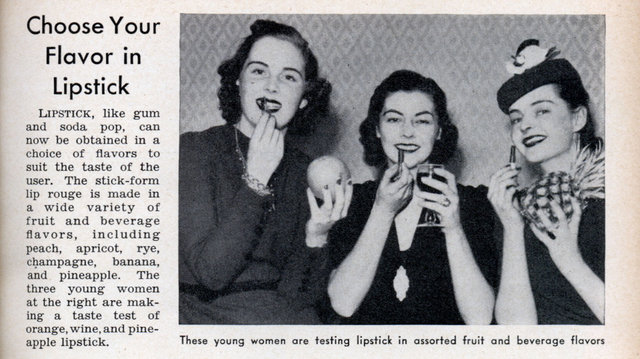 (image from blog.modernmechanix.com)
(image from blog.modernmechanix.com)
Roughly a decade later Harriet Hubbard Ayer released a clove-flavored lipstick.
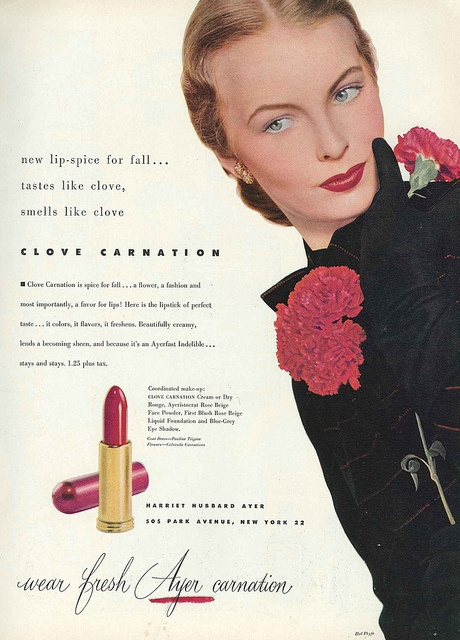
It was followed by this mint-rose scented lipstick in 1951.
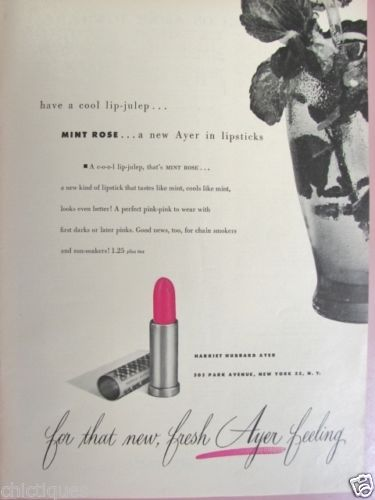
(images from ebay.com)
Slightly less sophisticated but extraordinarily popular among the teenage crowd, fruit-scented lip products really took off in the early '60s. Cutex claims to be the first company to offer fruit-flavored lipsticks in this 1964 ad. (You might remember this from my fruity ad round-up.)
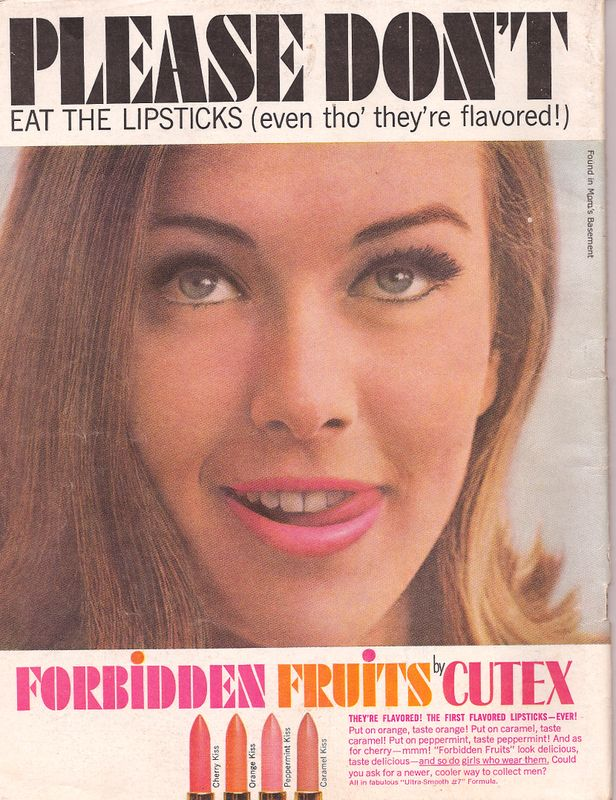 (image from buzzfeed.com)
(image from buzzfeed.com)
Soon after, in 1971, Yardley jumped on the fruit-scented lipstick bandwagon. I also remembered this one from the fruit ad post.
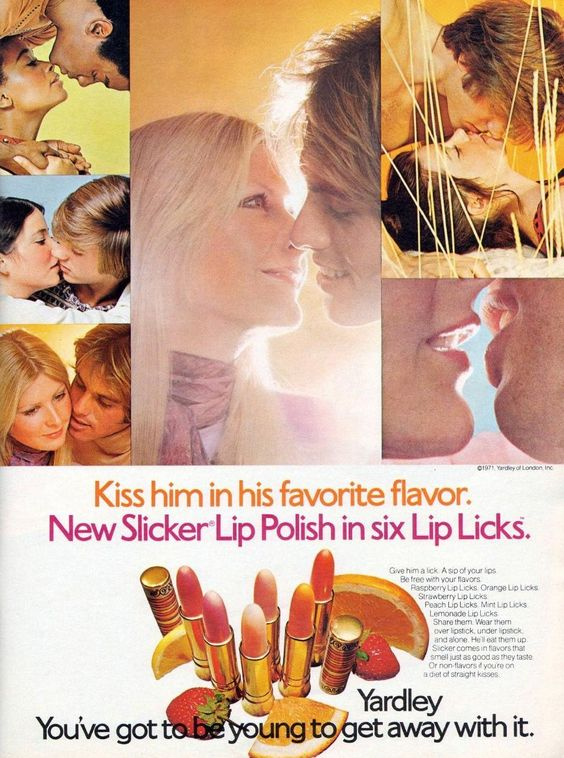
And in 1972, the company expanded the Lip Licks line to include dessert-inspired flavors (you might remember this ad from the Sweet Tooth exhibition.)
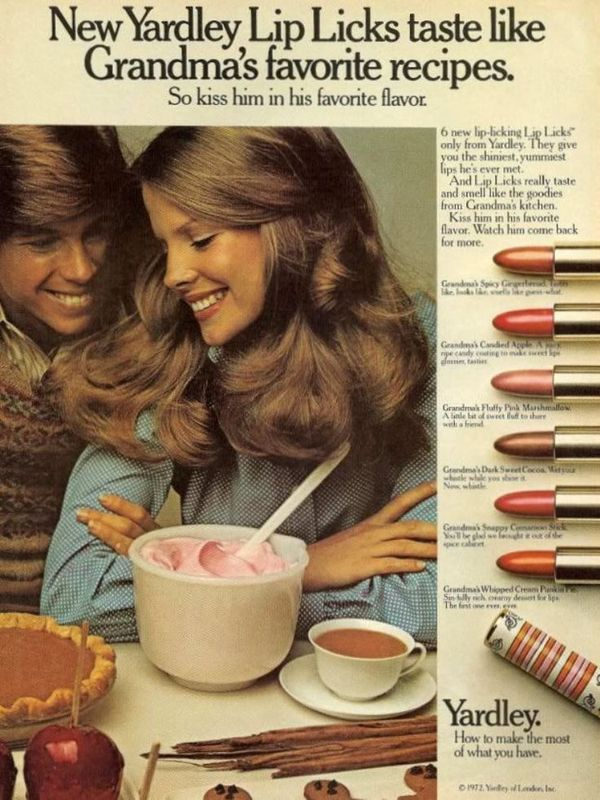 (image from flickr.com)
(image from flickr.com)
The foody-scented lip balm craze reached new heights in 1973, when a company named Bonne Bell introduced their Lip Smackers flavored balm. Starting with just 3 flavors, (strawberry, green apple and lemon), the company debuted their Dr. Pepper-scented balm in 1975, and soon Lip Smackers became a staple for tweens and teens everywhere. By 2012 the company offered 400 flavors worldwide. (Bonne Bell was purchased by Markwins in 2015, a company that still produces Lip Smackers today sans the Bonne Bell name).
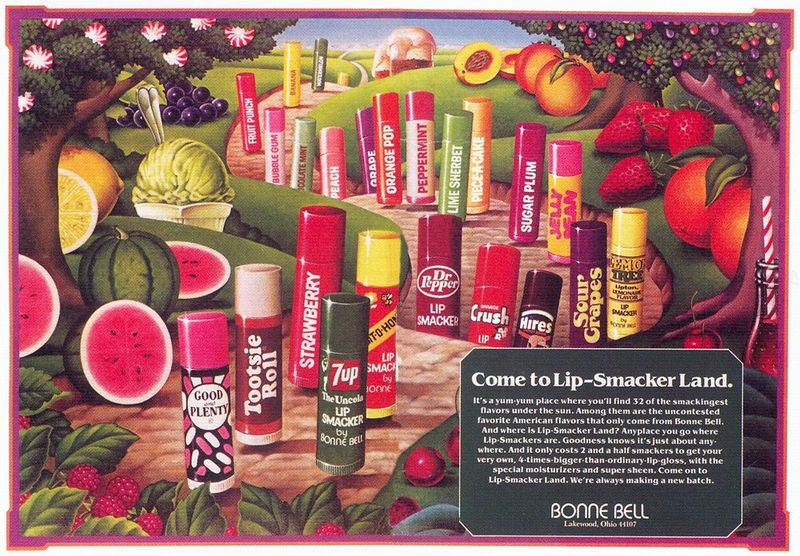 (image from oldadvertising.blogspot.com)
(image from oldadvertising.blogspot.com)
Avon wanted in on the action, as evidenced by these dessert-flavored balms that were released throughout the '70s and '80s. (I'm not sure exactly who these were being marketed to – I imagine it was mostly kids, but maybe some teenagers and adults bought them too.)
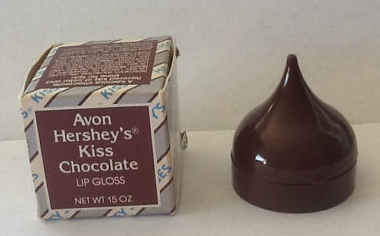
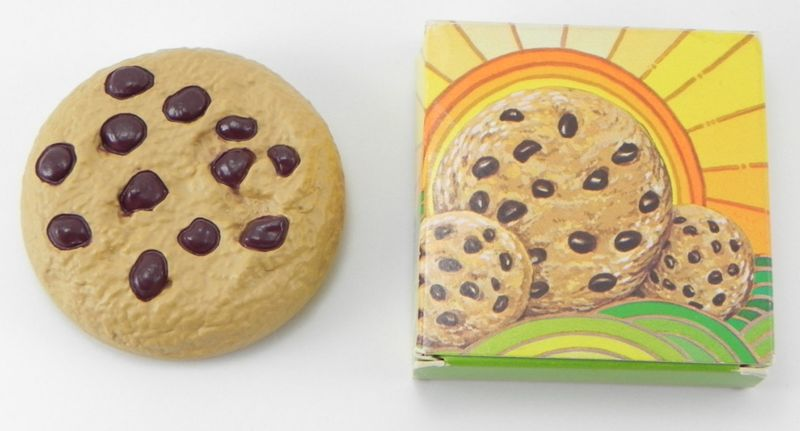
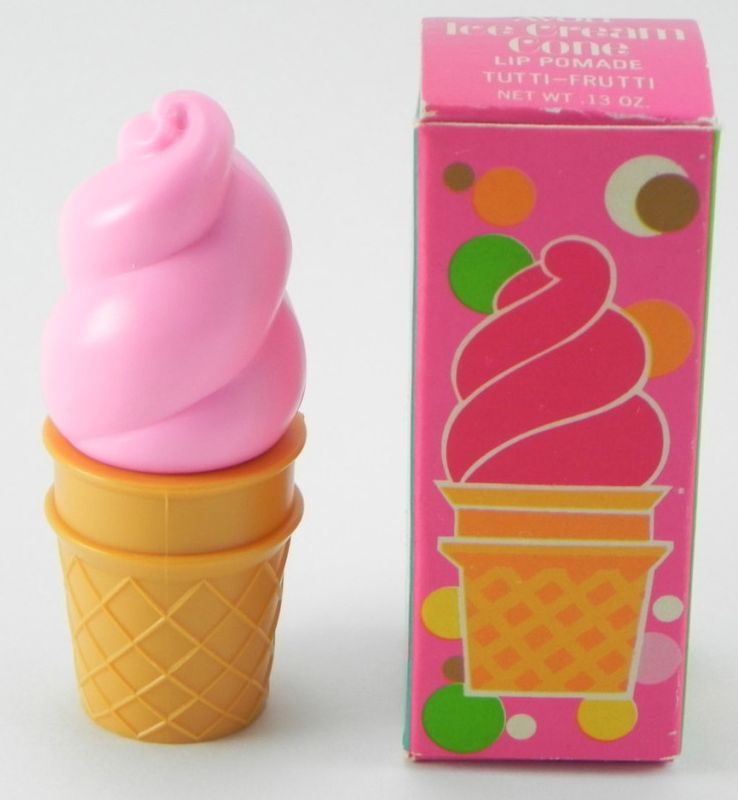
(images from etsy.com)
Thanks in large part to the enormously popular Lip Smackers line, other companies proceeded to try to get a piece of the teenage demographic by cranking out flavored lip products through the '80s.
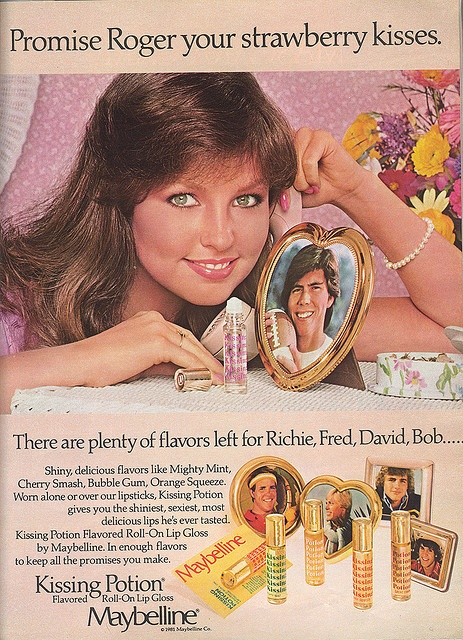
(image from liketotally80s.com)
By the early aughts, products like Philosophy's Lip Shines and On 10's vintage-inspired lip balm tins came in more upscale, less teenybopper-esque packaging and at a higher price point to appeal to a more grown-up crowd, but retained a few of the same scents as the inexpensive likes of Bonne Bell. In 2004 Tinte Cosmetics revived popular flavored balms that were known as "Lip Lickers" and produced by a Minnesota-based company from 1977 through 2002. In an effort to appeal to older women's nostalgic side, Tinte retained both the original sliding tin packaging and graphics. The food-scented balm market started to achieve full saturation around this time, especially when a company named Lotta Luv began partnering with big food and beverage companies like Hershey's, Pepsi, and Dairy Queen, along with a variety of other well-known snack, candy, cereal, and chewing gum brands. Novelty companies offering their own crazy food flavored balms soon sprung up afterwards. By 2012 one could find balms flavored in foods ranging from Cheetos and beer to pickles and corn dogs.
My hypothesis is that since foodie lip balms had officially jumped the shark with all these wacky flavors, coupled with the fact that makeup companies were only including lip balms among their scented cosmetic offerings, makeup brands had to get more creative when it came to adding fragrance to their products. No longer were clear lip balms enough – it was time to branch out into face and eye products, along with lip products that actually contained color. Chocolate and other desserts were still the reining favorites. But items like Stila Lip Glazes and Becca Beach Tints, both of which offered a variety of fruity scents, as well as Benefit's peach-scented Georgia blush, also proved popular. Some items unintentionally offered a subtle food aroma as a natural byproduct of the ingredients used, such as Bourjois's and Too-Faced's cocoa-powder based bronzers and 100% Pure's fruit-pigmented makeup line.

- Bourjois Bronzing Powder, 2006
- Benefit Georgia blush, 2004*
- MAC Lip Glass Tastis, 2004*
- 100% Pure Fruit-Pigmented Mascara, ca. 2007
- Urban Decay XXX Slick in Cocoa, 2004*
- Becca Beach Tint, ca. 2006
- Benefit SugarBomb blush, 2009
- Stila Lip Glaze, ca. 1999
- Jane Iredale Chocoholicks lip palette, ca. 2009
- Too-Faced Soleil Matte Bronzer, 2009
By 2012, foodie-smelling products were becoming less novel and more expected, but this familiarity among consumers didn't seem to diminish their popularity; even chocolate-scented makeup bags made an appearance. Additionally, as Asian brands became more visible and available to the Western world, sales of their chocolate-scented products took off as well.
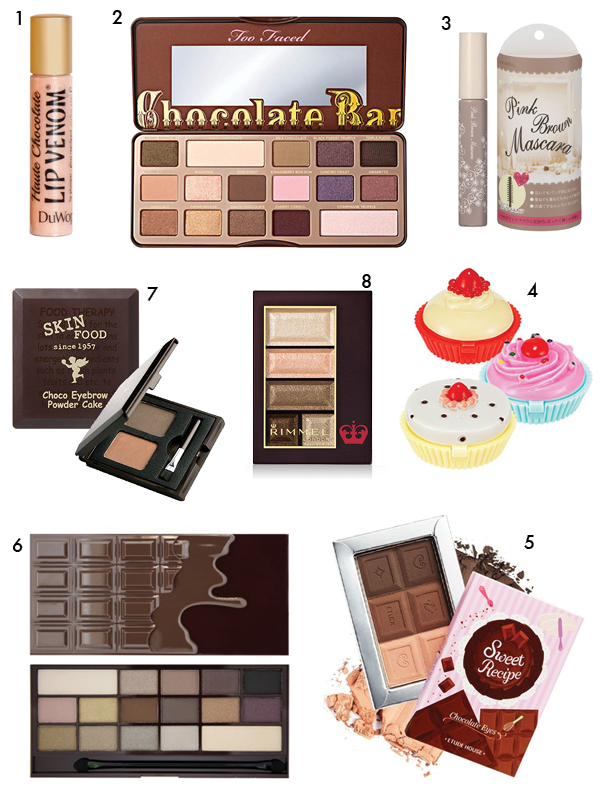
- DuWop Haute Chocolate Lip Venom, 2014
- Too-Faced Chocolate Bar palette, spring 2014
- Love Switch Pink Brown mascara, 2012
- Holika Holika Dessert Time Lip Balms, 2012
- Etude House Chocolate Eyes, spring 2013 (it should look familiar, as it was a key exhibition piece)
- Makeup Revolution Death by Chocolate palette, 2014
- Skin Food Choco Eyebrow Powder Cake, 2013
- Rimmel Chocolate Sweet Eyes, 2014
Face products weren't the only ones getting the food scent treatment, however. While scented nail polishes were previously the sole domain of children, nail companies soon seized on the demand among adults for these products. From Color Club's Pumpkin Spice Latte scented polish to Butter London's berry-scented polish remover, fingernails were now able to join in on the foodie fun. Whether it was partially Dior's rose-scented polishes from their spring 2012 collection or the influence of Rosalyn Rosenfeld's (played by Jennifer Lawrence) vivid description of a nail polish top coat's odor in the 2013 film American Hustle, scented nail products rose to prominence in the past 5 years. And the most popular ones smell not "like flowers, but with garbage"; rather, foodie polishes prove to be the best sellers.
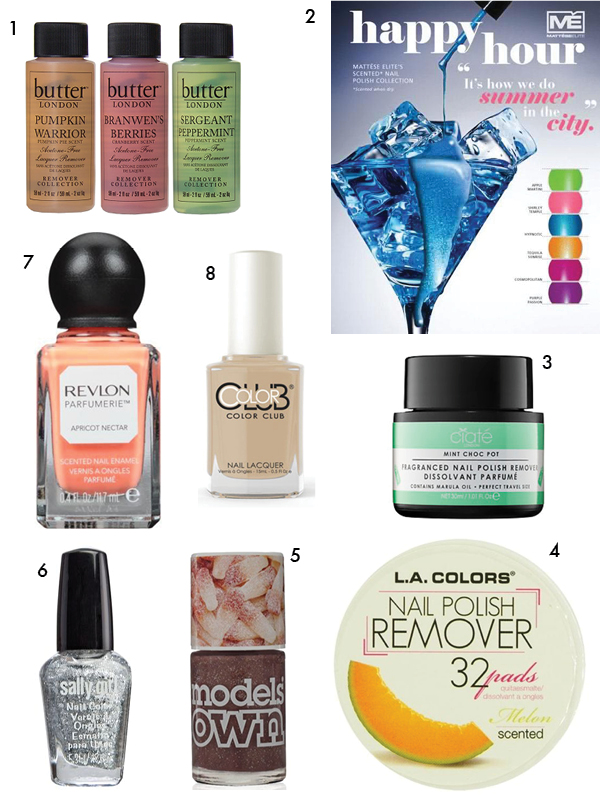
- Butter London polish remover trio, 2012 (I REALLY miss those Butter London polish removers – they were the best!! They smelled great and worked even better. They had another limited edition set that contained a pina colada-scented remover called Beach Bum, which I loved.)
- Ad for Mattese Happy Hour cocktail-scented polishes – if you can't make it out, the scents were Apple Martini, Shirley Temple, Hypnotic, Tequila Sunrise, Cosmopolitan, and Purple Passion.
- Ciaté Mint Choc Pot, 2015 (I think the Choc Pots are the reincarnation of Ciaté's previous foray into scented polish removers, which sucked – I wonder if the Choc Pots are any better).
- L.A. Colors Melon nail polish remover pads, ca. 2011
- Model's Own Sweet Shop Fizzy Cola Bottles, 2014 (the Sweet Shop collection is a follow up to Model's Own popular Fruit Pastel collection released the previous year)
- Sally Girl Vanilla scented polish, holiday 2014
- Revlon Parfumerie scented polish, 2013
- Color Club Pumpkin Spice Latte polish, ca. 2011 (this company has also released holiday-themed scented polishes)
Companies continue the foodie fad today. Too-Faced is leading the way with a whopping 5 new food-scented products in their spring/summer 2016 lineup. Japanese brands Lunasol and RMK both offered sweet-scented items in 2015, while Etude House built on their previous dessert-y releases with their Give Me Chocolate spring 2015 collection, a gingerbread cookie scented bronzer in their holiday 2015 collection, and strawberry-scented cream blushes and nail polishes for their spring 2016 collection. Finally, this spring Physician's Formula gets tropical with a coconut-scented bronzer.
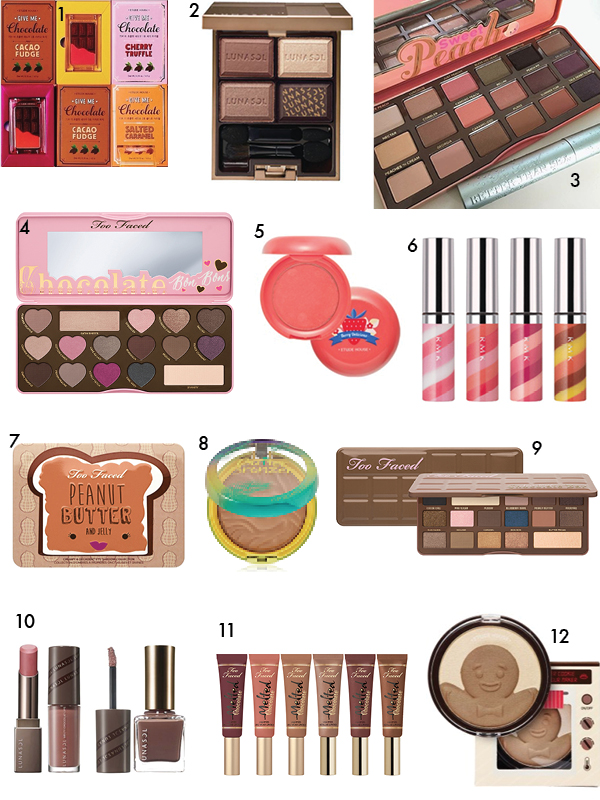
- Etude House Give Me Chocolate collection, spring 2015
- Lunasol Selection de Chocolat eyes, fall 2015
- Too-Faced Peach palette, spring/summer 2016
- Too-Faced Chocolate Bon Bons palette, winter/spring 2016
- Etude House Berry Delicious Cream Blush, spring 2016
- RMK Vintage Sweets collection lip glosses (flavors included Maple Syrup and Butterscotch), spring 2015
- Too-Faced Peanut Butter and Jelly palette, spring 2016
- Physician's Formula Butter Bronzer, spring 2016
- Too-Faced Semi-Sweet Chocolate Bar palette, spring 2015
- Lunasol Melty Chocolat lip glosses, fall 2015
- Too-Faced Melted Chocolate liquid lipsticks, spring 2016
- Etude House Gingerbread Cookie Contour Maker, holiday 2015
So, my questions are why companies are continuing to produce food-scented makeup, why we're buying it, and the significance of these items. There's the obvious need among makeup brands to offer novel products, plus the desire to capitalize on the success of foodie bath and body lines. Food-scented makeup is a natural expansion of the dessert-scented beauty product craze. There's also the tactic of engaging the sense of smell as well as sight (shiny makeup in pretty colors) and touch (texture is key when creating an attractive makeup product – people love dipping their fingers in testers). Appealing to 3 senses instead of two might make consumers more likely to buy the product. Why simply wear a buttery-soft, chocolate-colored eye shadow when your lids could also smell like it?
More generally, I suppose the same basic reasoning behind the allure of dessert-smelling bath and body items applies to cosmetics. I touched briefly on why women may want to smell like chocolate, cake or other food previously in this post and in the Sweet Tooth exhibition, and there have been plenty of news articles, but the most articulate and comprehensive exploration of the topic comes from Autumn of The Beheld. Her points regarding dessert-inspired beauty products, such as the negative implications of marketing of sweet-smelling products to grown women and the remarkable appeal they continue to maintain, carry over to food-scented makeup. She writes, "Foodie beauty products are designed to serve as a panacea for women today: Yes’m, in the world we’ve created you have fewer management opportunities, the state can hold court in your uterus, there’s no law granting paid maternal leave in the most powerful nation on the planet, and you’re eight times more likely to be killed by your spouse than you would be if you were a man, but don’t worry, ladies, there’s chocolate body wash!…[foodie products] do smell good, after all; that’s the whole point. And they trigger something that on its face seems harmless: Part of their appeal lies in how they transport us back to an age when all we needed to be soothed was a cupcake. At the same time, they don’t actually transport us to being that age; they transport us to a simulacrum of it." Indeed, nostalgia can be a tricky thing to navigate in this context. As with kids-themed cosmetics from brands that primarily sell to adult women, the notion of foodie makeup could be seen as an infantilizing pacifier meant to placate and distract women from serious societal issues.
Another aspect to consider is the advertising for these products. Today's foodie makeup isn't advertised the same way as their predecessors, who suggest these products are a good way to snag a guy. "Could you ask for a newer, cooler way to collect men?" asks the Cutex ad. "Kiss him in his favorite flavor," says Yardley. (Side note: the notion of making a guy think of his grandmother while kissing is really bizarre to me, and I'm not the only one.) "Promise Roger your strawberry kisses," implores Maybelline. Heck, the product is even named Kissing Potion!
While the insinuation of catching a man isn't present in the vast majority of contemporary makeup ads, the idea is still vaguely floating around when it comes to food-scented items. A reviewer for Too-Faced Chocolate Soleil bronzer titles her review, "Even my boyfriend loves the smell." And the model for Switch's Pink Brown mascara remarks, "You can feel the chocolate scent from my lushes! [sic] And I love it when the scent flows as your face getting close to your boyfriend, like when kissing." (The translation wasn't great but you get the gist.) The notion of luring a guy with a scrumptious dessert scent certainly isn't unique to makeup, but it's slightly different. Unlike bath and body products or perfumes, one has to be up close to get a whiff of a flavored balm or cocoa bronzer.
But this fact is also why one could argue that people who wear these items are only doing it for themselves, and that we may be reading too much into these: perhaps they really are just food-scented makeup and nothing more. Like Autumn, ultimately I don't see anything wrong with enjoying makeup that smells like fruit or chocolate or any other food. She notes, "[Sometimes] a candy cigar is just a candy cigar…I don’t want to imply that any of us should stop using lemon cookie body souffle or toss out our Lip Smackers—joy can be hard enough to come by plenty of days, and if it comes in a yummy-smelling jar, well, that’s reliable enough for me not to turn my nose up at, eh?" Speaking from personal experience, I loved Benefit's Georgia – something about having my cheeks smell faintly like peach was incredibly fun – but I can tell you I didn't consider, not for a second, my then boyfriend's (now husband) reaction to how my face smelled. At the moment I'm tempted by Too-Faced's Peanut Butter and Jelly palette because not only is the smiley pb & j face ridiculously cute, the palette is scented with peanuts. That is a fragrance I haven't seen in eye shadow before; the sheer novelty of it brings a smile to my face. I'm not even a palette person, but the idea of inhaling a light peanut aroma while applying eye shadow is the aspect that makes me want to buy it. I imagine that for most women, it's not about getting close to a significant other, it's about the multi-sensory pleasure you experience when applying these products. I'd say that given how subtle and ephemeral the scents in foodie makeup are, they're actually intended to be enjoyed at a personal, individual level rather than something to be shared. As one reviewer for Revlon's Parfumerie nail polish notes, "It's funny because you forget about it, and then I guess I don't realize how many times a day I touch my face, because I keep getting a whiff of it, and each time I'm totally surprised!” Overall, no matter what makeup companies have in mind when creating these products, I think it's okay to perceive them simply as brief, fleeting pick-me-ups rather than as ways to entrapping a man or treating grown woman like children. Of course it's a subject worth questioning and we must continue to be mindful of how makeup is marketed, but no one should feel bad for liking chocolate-scented mascara or nail polish that smells like cookies.
What do you think? Are you down with food-scented makeup? This very unscientific 2008 poll says that people are fairly evenly divided on the subject, so I'm curious to hear your thoughts.
*Limited edition/discontinued
 (image from baltimoreshoeseum.com)
(image from baltimoreshoeseum.com)  (image from etsy.com)
(image from etsy.com) (image from etsy.com)
(image from etsy.com)

 (image from library.duke.edu)
(image from library.duke.edu)  (image from library.duke.edu)
(image from library.duke.edu)  (image from periodpaper.com)
(image from periodpaper.com) (image from etsy.com)
(image from etsy.com)  (image from flickr.com)
(image from flickr.com)
 (image from etsy.com)
(image from etsy.com) (image from library.duke.edu)
(image from library.duke.edu) (image from library.duke.edu)
(image from library.duke.edu)  (image from pinterest.com)
(image from pinterest.com) (image from mudwerks.tumblr.com)
(image from mudwerks.tumblr.com) (image from pinterest.com)
(image from pinterest.com) (image from adweek.com)
(image from adweek.com)  (image from pinterest.com)
(image from pinterest.com)



























